Mastering Meta Ads Attribution: A Comprehensive Guide for Advertisers

Understanding how Meta Ads Attribution works is crucial for advertisers aiming to optimize their campaigns effectively.
Attribution is not just about tracking conversions but understanding the journey that leads to these conversions. This comprehensive guide explores the different aspects of Meta Ads Attribution, helping you navigate the complexities and make informed decisions for your advertising strategy.
Table of Contents
- The Importance of Attribution Settings
- Understanding and Comparing Attribution Settings
- Click Attribution Explained
- The Controversy of View Attribution
- Engaged-View Attribution
- First Conversion Reporting
- Incremental vs. Standard Attribution
- Crafting Your Attribution Story
- Conclusion
The Importance of Attribution Settings
Attribution settings in Meta Ads play a pivotal role in determining how conversions are credited to your ads. When you choose a website conversion location with a goal to maximize conversions, your results are measured based on these conversions. The default attribution setting typically involves a 7-day click and 1-day view, but there’s much more to it than meets the eye. Understanding and configuring these settings correctly is essential for accurate reporting and optimization.
Understanding and Comparing Attribution Settings
One of the most valuable tools available in Meta Ads Manager is the ability to compare attribution settings. This feature allows you to analyze how different settings affect your conversion data. By comparing various attribution windows, such as 1-day, 7-day, and 28-day clicks, you can gain insights into the customer journey and the effectiveness of your ads. This tool is crucial for identifying inflated results and uncovering conversions that may not be immediately apparent.
Click Attribution Explained
Click attribution measures conversions that occur after someone clicks on your ad. However, it’s not always as straightforward as it seems. There are several factors to consider:
- Day Windows: Conversions can be tracked within 1, 7, or 28 days of clicking an ad. This means a conversion might not happen immediately but still be attributed to the initial click.
- Cross-Device Tracking: Conversions might occur across different devices, making it challenging to track accurately. Meta uses sophisticated methods to connect these conversions to the original click.
- Any Click: Any interaction with your ad, not just clicks to your website, can be counted as a conversion. This can lead to discrepancies with third-party reporting tools.
The Controversy of View Attribution
View attribution credits conversions to ads that were viewed but not clicked. This can be controversial, as it raises questions about whether the ad genuinely influenced the conversion. While view-through conversions can inflate results, they can also highlight the impact of your ads. It’s essential to scrutinize these conversions and understand their value in the context of your campaign.
Engaged-View Attribution
Introduced in 2023, engaged-view attribution focuses on video ads. It tracks conversions from users who watched your video for at least 10 seconds before converting. This metric provides valuable insights into the effectiveness of video content and its role in driving conversions.
First Conversion Reporting
First Conversion reporting, introduced in 2024, helps advertisers understand unique customer conversions. By focusing on the first conversion within a specified window, it provides a clearer picture of unique customer interactions, reducing potential inflation from multiple conversions by the same user.
Incremental vs. Standard Attribution
Meta’s Incremental Attribution aims to refine conversion tracking by focusing on conversions directly caused by ads. Unlike Standard Attribution, which emphasizes volume, Incremental Attribution uses advanced models to filter out less relevant conversions, aligning more closely with third-party reporting.
Crafting Your Attribution Story
Understanding Meta’s attribution settings is about crafting a narrative that accurately reflects your campaign’s impact. Utilize the tools available to analyze and adjust your settings, ensuring that your attribution story aligns with your advertising goals. By doing so, you can make informed decisions that enhance your campaign’s effectiveness.
Conclusion
Mastering Meta Ads Attribution is not just about understanding the technical aspects but about leveraging this knowledge to optimize your advertising strategy. By carefully analyzing and adjusting attribution settings, you can gain deeper insights into your campaign’s performance and make data-driven decisions that drive success. Whether you’re focusing on click, view, or engaged-view attribution, understanding these elements will empower you to tell a more accurate and compelling attribution story.
2025 Tendency LTD. All rights reserved.

